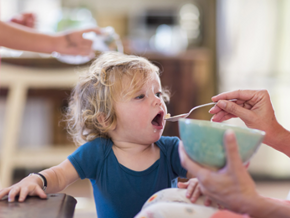
First foods can influence your child’s future tastes
Did you know? Now that your baby is six to eight months old, exposure to a variety of nutritious foods, flavors, and textures can help shape your baby’s likes and dislikes when he’s a child.
When your baby opens his mouth for his first taste of food, he embarks on a journey of discovery that may influence his food preferences for the rest of his life. Up until now, your little one has relied purely on your breast milk to grow and develop. And look how far he has come! Now he needs some additional nutrients, and the foods you choose to offer him are essential for his future health.
Incredibly, what you offer on his spoon during these early weeks of feeding can influence the variety of foods he will choose to eat in the future. Not just next month, or even the one after, but in years to come when he’s waving goodbye to you at the school gates.
Vary the menu
So how do you help your baby grow into a child with a healthy diet? One important way is with variety. Offer different vegetables during these early weeks of complementary feeding and he’ll be more likely to accept new vegetables now, and in the future. One recent study showed that an introduction of vegetables early in the complementary-feeding period may lead to a greater acceptance of vegetables by babies, and later in life by children.
Beyond the smooth
As well as offering a wide range of vegetables, it is important for your baby to learn about texture as his feeding skills develop. Once your baby is experienced with, and able to manage, smooth purees, think about adding some texture, perhaps by mashing developmentally appropriate food with a fork rather than blending to a thick liquid.
Research shows that babies who are introduced to ‘lumpy’ textures before nine or 10 months of age are more likely to eat family foods, healthy foods, and a greater variety of fruits and vegetables as toddlers and at school age. “Introducing your baby to texture early on may help him accept more complex textures when he’s older,” says Laurence Stoll, Complementary Food Nutritionist at Nestlé Nutrition, Switzerland. All of this goes to show that it’s never too early to start positively influencing your child’s health.
Sources
Coulthard H, Harris G, Emmett P. Delayed introduction of lumpy foods to children during the complementary feeding period affects child’s food acceptance and feeding at 7 years of age. Matern Child Nutr 2009; 5(1):75-85.
Hetherington MM, Schwartz C, Madrell J et al. A step-by-step introduction to vegetables at the beginning of complementary feeding. The effects of early and repeated exposure. Appetite 2015; 84:280-90.
Maier A, Chabanet C, Schaal B et al. Effects of repeated exposure on acceptance of initially disliked vegetables in 7-month old infants. Food Quality and Preference 2007; 18:1023-32.
Maier-Noth A, Schaal B, Leathwood P et al. The lasting influences of early food-related variety experience: A longitudinal study of vegetable acceptance from 5 months to 6 years in two populations. PLoS One 2016; 11(3):e0151356. doi:10.1371/journal.pone.0151356.


















